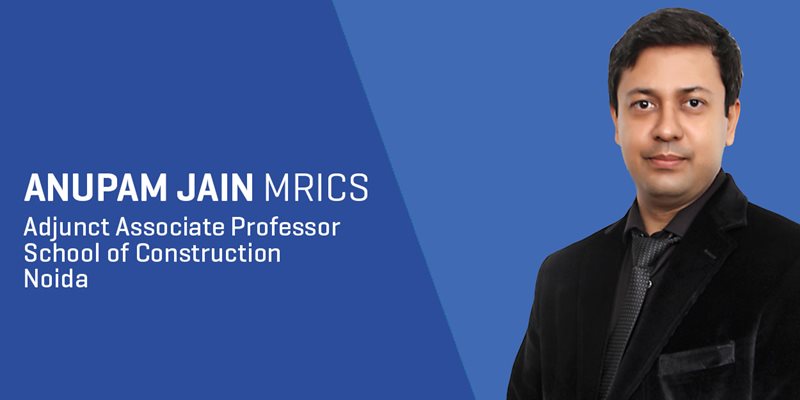Read about evolution of Facility Management companies by Anupam Jain MRICS, Adjunct Associate Professor, School of Construction, RICS School of Built Environment.
Read about evolution of Facilities Management companies by Anupam Jain MRICS, Adjunct Associate Professor, School of Construction, RICS School of Built Environment.

Facility management (FM) is traditionally understood as an enabler for the smooth functioning of a building complex. This concept was largely limited to large commercial buildings that required professional maintenance. With the advent of group housing complexes, there is now an established and additional demand for extending such services to manage and operate residential properties.
In the meantime, commercial property management has grown in its own segment to engage more meaningfully with the occupant businesses and streamline operations to enhance business potential. This article explores both the residential and commercial segments to understand the need for professional management of assets. Let us first look at how the sector has evolved in its stronghold: the commercial segment.
Commercial and Office Buildings
In a commercial complex or building apart from housing businesses, there are additional functions that a facility performs. Supplementing regular operations and maintenance, commercial requirements mandate the use of the built facility as an asset for business purposes. For a successful business, optimization of resources is the key.
One of the biggest cost centres for a business is the salary of its employees. Happy, productive employees can contribute immensely to the bottom line of the business. This can be facilitated through a variety of means to enhance the workplace. On the other hand, hindrances in the physical environment can reduce productivity of employees and result in a higher attrition rate.
Therefore, a good facility is one where the physical environment is conducive for daily business functions. It should also be a resource for the business to draw upon to supplement their daily functionality. The former is in the form of hard services such as housekeeping, security, workplace design and the like while the latter is usually in the form of soft services that a business requires such as internet and telecom connectivity, mail handling, hot desking, front office services, billing and finance, office administration, lease administration, staffing and payroll management.
The occupiers of modern commercial spaces are increasingly becoming aware of such soft services and are demanding them from their maintenance agencies. This has led to the emergence of an evolved model of facility management companies wherein it is no longer sufficient for them to provide hard services to their clients. Understanding the core business functions of the occupants, why they have made a decision to be in a particular region, why that particular building, how does their presence affect their business in the market, what do they need to operate and how to customize the facility to support them – these are key questions this new breed of facility managers are asking. They no longer see themselves as “vendors” alone and are increasingly growing to become “business associates” for the tenants and occupiers of the buildings that they manage.
These new age property management companies hire professionals trained in the art and science of facility management. Ranging from real estate economics to supply chain management, these professionals are trained to understand market demands and implement solutions that can directly benefit occupants of a property. Technology has been a strong enabler, especially on the implementation side for taking care of repetitive functions such as billing and monitoring. Professionals also take care of maintenance and vendor management of complex equipment present on sites.
Residential Complexes
In the residential market, an increasing number of multi-family complexes are now being absorbed by end users. Living in plotted houses, people have traditionally managed operations themselves. However, in community living no single individual has full ownership of the vast common areas and hence intent or resources to maintain them. Community living brings with itself a need to manage operations professionally. This results in more facilities, such as a dedicated security workforce, and better quality of service for example through the availability of repairmen through a single point of contact, which is usually the facility office.
The nature of services available to residents also changes. For instance, as compared to a bungalow in plotted housing elsewhere, in community living residents enjoy the benefits of large infrastructure like uninterrupted power backup, availability of recycled water through separate pipelines for toilet flushing and landscaping, electronic and sprinkler based firefighting provisions, in-campus electrical transformers, CCTV surveillance, and recreational activities in the club house that often includes a swimming pool, gym, daily needs shops, sports activities and other common infrastructure within their residential complex.
In addition to such facilities, community living is supported by a series of administrative functions such as apartment-wise billing for maintenance, electricity recharge, water and sewage, and garbage collection. These can no longer be managed by a group of volunteers from within the community since such efforts will easily lead to a rather fast depreciation of the asset.
Therefore, similar to the commercial segment, for proactive management of an apartment complex it is essential to regularly monitor the health of different equipment and systems to avoid any malfunctions and surprises. This requires expertise in handling engineering and management tasks that professional facility managers assist with. As the discipline and scope of such professionals continues to grow, it should be no surprise to see higher standard of living and a better quality of life for the occupants.
This article was originally published on 99acres.com on June 20, 2017
Author:- Anupam Jain